

10/05/2021
Can Gio mangrove forest (CGM) is a low-lying area in the estuary of the Dong Nai – Sai Gon river basin, where pollutants from megacities have been consecutively discharged into. The mangrove forest was also a military base zone destroyed by sprayings of defoliants. Seventeen samples were selected in separated depths of two sediment cores in the CGM to analyze for dioxins by chromatographic mass spectrometry according to Japanese standard named JIS K 0312 in the lab of Yagai Kagaku Co.Ltd, Japan. The results show that PCDDs/Fs and PCBs concentrations stably distributed in depth with a little change and probably represented for background concentrations in the last 20 years. Total WHO-TEQ concentrations that are in the range between 2.1 and 13 pg-TEQ/g-dw, far lesser than those of threshold effect levels (TELs), probable effect levels (PELs) of Canada and of officially regulatory standards of Vietnam, so they indicate a good sediment quality for benthic organisms. The anomaly of 13 pg-TEQ/g-dw detected in 95 ± 10 cm of the core TK10 may have originated from defoliants sprayed during the Vietnam war, it can probably appropriate be used to verify sediment age in the CGM.
Introduction
Development of megacities located along the Dong Nai – Sai Gon river basin over the past five decades is highly regarded achievements. Beside the cities’ achievement, environmental problems also need to be carefully considered. Previous studies based on polychlorinated dibenzo-p-dioxins and polychlorinated dibenzofurans (PCDDs/Fs) and PCBs known as hydrophobic organic compounds (HOCs) or dioxins in sediments have been mainly conducted in urban canals and major rivers such as Dong Nai, Sai Gon, Soai Rap, Long Tau and Thi Vai. These results mostly show a trend of pollution due to human activities (Phuong, et al. 1998, Anh, et al. 2003, Minh, et al. 2007, Shiozaki, et al. 2009). In particular, artificial dioxin concentrations in sediments have been ascendingly found from industrial production, agriculture, urban discharge and defoliants used in the Vietnam war (Thuong, et al. 2014). These dioxins are widely known as harmful substances to benthic organisms and also to human health when mostly exposed via their consumption of animal products (Heimstad, et al. 2015). Sediment quality based on dioxin concentrations in sediments in the CGM is assessed according to TELs and PELs of Canada (Canadian Council of Ministers of the Environment 2019) and standards of Vietnam (Ministry of natural resources and environment 2012).
Duration of dioxins in the environments is very diverse, depending on specific environmental conditions. Dioxins in sediments could exist for several hundred years (Bopp, et al. 1991, Kjeller and Rappe 1995). About 50 years after the Vietnam war ended, elevated concentrations of dioxins were detected in soils and sediments in Bien Hoa airport, base zone D (Thuong, et al. 2014, Huyen, et al. 2015, U.S Agency for International Development 2016).The CGM was an important military base zone, was sprayed about 803,125 gallons defoliants down consisting of agent orange, agent white, agent blue and agent purple, and was destroyed nearly 57% of the mangrove area (U.S. Air Force Communication Services 1965, U.S. National Academy of Sciences 1974). Some studies in the CGM had been experimented for dioxins in surface sediments in 1974, 2004 and 2010 sourced artificially (Shiozaki, et al. 2009, Kishida, et al. 2010). However, dioxin concentrations distributed in deep sediments corresponding to the wartime have not been studied, and sediment quality has not been accessed. Therefore, the study aims to contribute to clarifying the sediment quality and to elucidate dioxins sources distributed in sediments in the CGM.
Study site and method
Study site
Located in the Dong Nai – Sai Gon estuary, the CGM has a strategical position for Ho Chi Minh City and its surrounding areas. These are mangrove swamps with low-lying, basin-shaped terrain interwoven with a system of rivers, tidal creeks and with many mangrove species. In 2000, UNESCO recognized the CGM as an international biosphere reserve, it has been also being developed as a tourist center for Ho Chi Minh City and the region (Tuan, et al. 2002).
Two sediment boreholes of 2 m depth entirely drilled in the CGM were shown in Figure 1. Boreholes TK10 was sampled in a basin-centered landform often with water. Borehole TK16 was selected in a small low shape-opened creek, dry at low tide. All boreholes were drilled in defoliants-sprayed areas in the CGM during the Vietnam war.
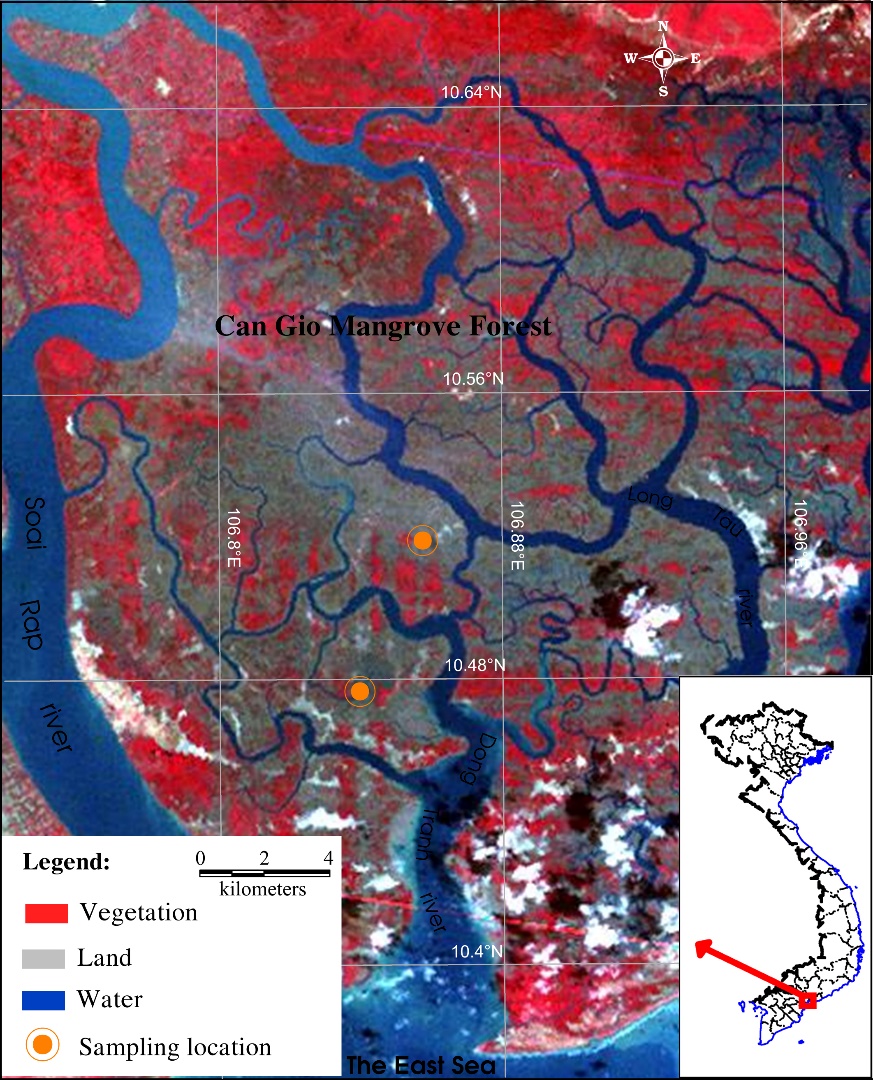
Figure 1. Sampling locations based on a landsat image in 1973
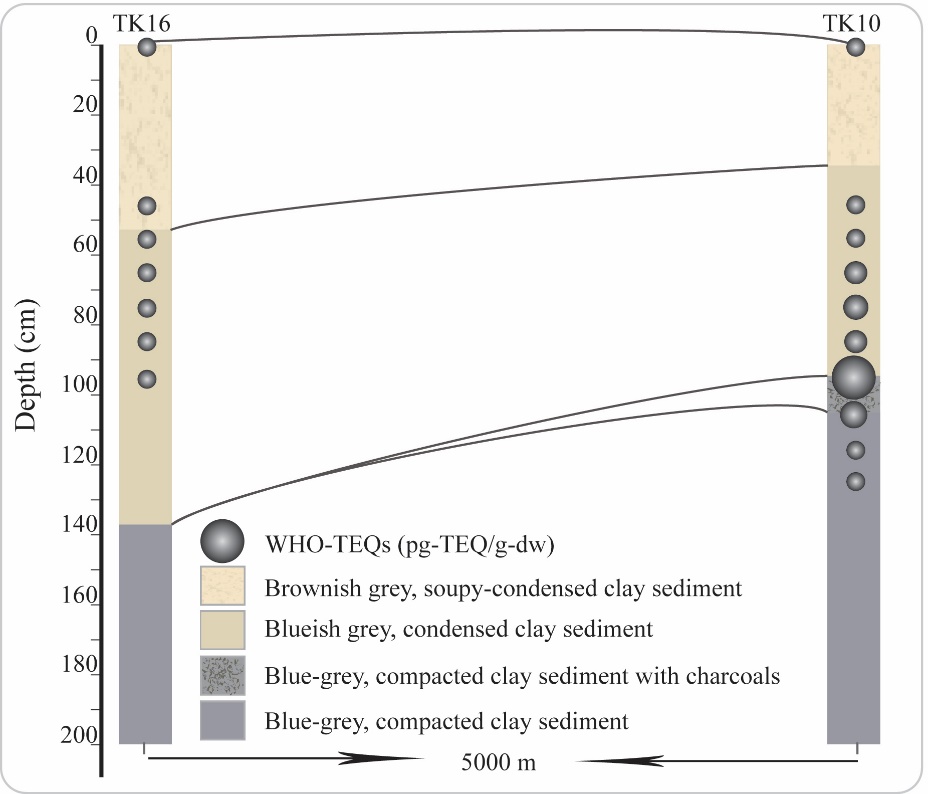
Figure 2. Description of the cores TK10 and TK16, with WHO-TEQ concentrations distributed in specifically separated depths the cores
Method
Sampling samples
After description at field, two cores TK10 and TK16 were quickly transported to a lab of Ho Chi Minh city University of Technology, and then were sliced into 10 samples and 7 samples in specifically separated depths illustrated in Figure 2, respectively. Each slice of 2cm thickness was continuously cut its surrounding parts off to a sample of 2cm x 2cm x 2cm. All sediment samples were carefully weighed, wrapped with aluminum foils, Polyvinyl clorua PVC zipped bags, and labeled before being sent to Japan for analyzing dioxin.
Chemical analysis
All 17 sediment samples were analyzed for dioxins at YAGAI-KAGAKU, 2-39, 12-Chome, Naebocho, Higashi-ku, Sapporo, Hokkaido 065-0043 laboratories, according to Japanese analytical standards abbreviated to JIS K0312 (Japan Ministry of the Environment 2018). The samples were dried up at room temperature. Each 20g dry samples were placed in a centrifuge tube, and then were analytically experimented through four brief stages of chemical analysis for dioxins. Firstly, soxhlet extraction with toluene was done in 16 hours. Secondly, crude extracted solvent was evaporated, filled up to 100ml, and then eluted with n-hexane, concentrated through multi-layer silica-gel column chromatograph with adding internal standards as a clean-up spike. Thirdly, the outcomes were sequently evaporated, and then were in turn injected into an active charcoal column chromatograph with n-hexane, 25% dichloromethane/hexane and toluene. Finally, these products were provided for a gas chromatograph – mass spectrometer (GC-MS, JEOL, Japan). WHO-TEQs were calculated according to WHO-TEFs (2006) (Van de Berg 2006).
Quality assurance and quality control
To ensure the quality of the analytical results, sampling and analytical equipment was regularly cleaned with acetone-hexane solvent. A sediment sample selected in Hokkaido, Japan was used as a standard result with the same analytic procedure, and consequently continued with all sediment samples drilled in the CGM. The results were repeated 3 times to test and control their qualities. In addition, regularly check was conducted for the recovery of samples from 50% to 120% according to the Japanese standard.
Results and discussion
Presence and sources of PCDD/Fs and PCBs in sediments
Concentrations of PCDDs/Fs and PCBs in depth of the cores TK10 and TK16 are shown in Table 1 and Table 2 respectively. Of core TK10, PCDDs, PCDFs and PCBs appear in all separated depths of the core with different concentrations. Contribution percentages of tetra chlorodibenzo-p dioxin (2,3,7,8-TCDD) to total WHO-TEQ in figure 3 are from 44.4% to 88.4%. This shows that 2,3,7,8-TCDD concentrations in the Can Gio area are probably derived from human activities, when compared with those in other studies given in table 3 (Yake, Singleton and Erickson 1998, Ferrario and Byrne 2000, Gadomski, et al. 2004, Holmstrand, et al. 2006, Horii, et al. 2008). 2,3,7,8-TCDD proportion has not been found in any depth of the sediment core taken at coastal area of Can Gio (Shiozaki, et al. 2009). This indicates that dioxins was artificially generated in sediments in the CGM.
Total WHO-TEQ within 2.7 - 13.0 pg-TEQ/g-dw was distributed in separated depths of the core TK10, suggesting that volumes of artificial dioxins penetrated into sediments over time. Low dioxin concentrations from 2.7 to 7.2 pg-TEQ/g-dw were detected in surface sediments (I, II) and bottom sediments (IV), with their contribution ratios of 2,3,7,8-TCDD to the total WHO-TEQ about 44.4% and 75.0%, respectively. Total percentages of four congeners (N4) including 1,2,3,7,8-PeCDD, 1,2,3,6,7,8-HxPCDD, 1,2,3,7,8,9-HxPCDD and 1,2,3,4,6,7,8-HpCDD account for 25.8% to 39.8%, and percentages of 2,3,4,7,8-PCDF and 3.3',4,4',5-PeCB are near 5%. Proportions of PCDFs and PCBs contributed to total WHO-TEQ are low, however, 2,3,7,8-TCDD percentages are greater than those of N4, and are much greater than 2,3,7,8-TCDD percentages within 10% - 31% according to Shen's study (2008) in Lake Erie and Ontario (Shen, et al. 2008). According to Gadomski et al (2004) and Gaus et al (2001), the percentages of 2,3,7,8-TCDD were greater than those of N4, dioxins were derived from artificial sources. The total WHO-TEQ and the percentage of 2,3,7,8-TCDD in this study are relatively equivalent to those in surface sediments in the CGM, which were studied in 2004 (Kishida, et al. 2010) and in surface sediments along Sai Gon river in 1998 and 2009 (Phuong, et al. 1998, Shiozaki, et al. 2009). As a result, dioxin concentrations in surface sediments in the areas have not considerably changed for about 20 years, and have mainly originated from artificial sources.
Meanwhile, total WHO-TEQs in 95 ± 10 cm depth cm are r 13 (pg-TEQ/g-dw) and 9.5 (pg-TEQ/g-dw), 3 to 4 times higher than those in surface (I) and bottom (IV) sediments of the core. Figure 3 illustrates 2,3,7,8-TCDD percentages in the range of 84.6 - 88.4%, N4 group in the range of 7-10% and group of PCDFs, PCBs only 4%. Previous studies of dioxins in sediments showed that percentages of 2,3,7,8-TCDD in Bien Hoa ranged within 66% - 99% (Thuong, et al. 2014, U.S Agency for International Development 2016) and in A Luoi ranged within 41% - 90% (Dwernychuk, et al. 2002), produced from 2,4,5-Trichlorophenol in agent orange substances. Therefore, the 2,3,7,8-TCDD percentages in 95 ± 10 cm depth of the core TK10 could be in proportion to those detected in sediments in Bien Hoa and in A Luoi, and could be suitable for spraying period of defoliants down the CGM during the Vietnam war.
Table 1. Concentration of isomers (pg/p-dw) by depth of the core TK10
|
Depth (cm) |
Concentrations of each isomers (pg/g-dry) |
||||||||||||
|
PCDFs |
PCDDs |
PCBs |
|||||||||||
|
TeCDFs |
PeCDFs |
HxCDFs |
HpCDFs |
OCDFs |
Total |
TeCDDs |
PeCDDs |
HxCDDs |
HpCDDs |
OCDD |
Total |
||
|
0 |
6,6 |
4,3 |
3,1 |
2,7 |
2,3 |
19 |
10 |
13 |
56 |
88 |
290 |
460 |
40 |
|
-45 |
10 |
4,2 |
2,2 |
1,2 |
0,5 |
18 |
11 |
16 |
73 |
96 |
270 |
470 |
57 |
|
-55 |
13 |
4,8 |
2,2 |
1,1 |
0,5 |
22 |
13 |
16 |
72 |
97 |
270 |
470 |
58 |
|
-65 |
12 |
4,8 |
2,5 |
1,6 |
0,7 |
22 |
16 |
19 |
77 |
110 |
350 |
570 |
65 |
|
-75 |
13 |
5,0 |
2,9 |
1,9 |
0,9 |
24 |
18 |
20 |
76 |
100 |
310 |
520 |
48 |
|
-85 |
12 |
4,4 |
2,2 |
1,3 |
0,7 |
21 |
16 |
18 |
81 |
110 |
310 |
540 |
43 |
|
-95 |
13 |
5,1 |
2,8 |
1,9 |
1,0 |
24 |
23 |
19 |
77 |
110 |
340 |
570 |
53 |
|
-105 |
8,5 |
3,0 |
1,3 |
0,8 |
ND |
14 |
18 |
14 |
55 |
68 |
220 |
380 |
37 |
|
-115 |
12 |
4,5 |
1,6 |
0,6 |
ND |
19 |
13 |
17 |
71 |
110 |
350 |
560 |
21 |
|
-125 |
11 |
4,0 |
1,3 |
0,4 |
ND |
17 |
15 |
18 |
72 |
110 |
340 |
560 |
6,7 |
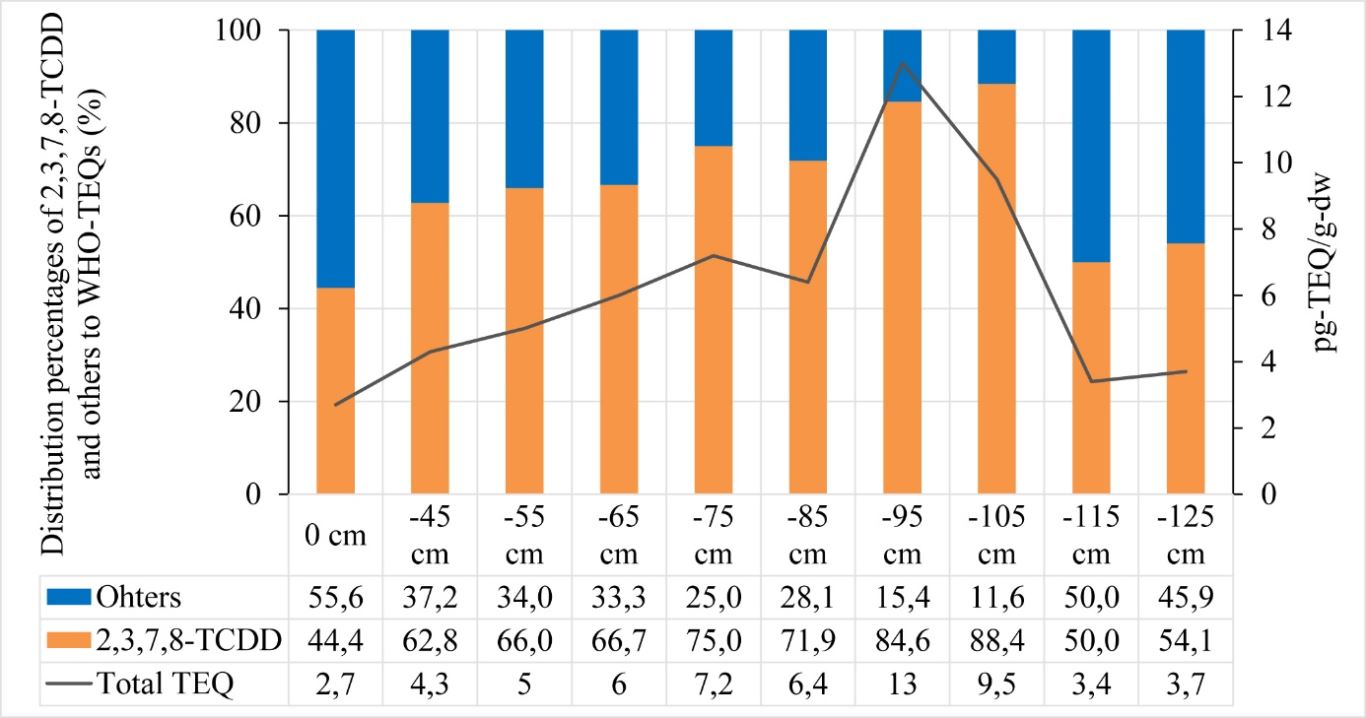
Figure 3. WHO-TEQs concentrations (pg-TEQ/g-dw) and percentages of 2,3,7,8-TCDD (%) by depth of borehole TK10 (cm)
Table 2. Concentration of isomers (pg/p-dw) by depth of the core TK16
|
Depth (cm) |
Concentrations of each isomers (pg/g-dry) |
||||||||||||
|
PCDFs |
PCDDs |
PCBs |
|||||||||||
|
TeCDFs |
PeCDFs |
HxCDFs |
HpCDFs |
OCDFs |
Total |
TeCDDs |
PeCDDs |
HxCDDs |
HpCDDs |
OCDD |
Total |
||
|
0 |
9,3 |
5,5 |
3,6 |
2,8 |
2,5 |
24 |
12 |
16 |
64 |
100 |
370 |
560 |
33 |
|
-45 |
9,8 |
4,8 |
3,0 |
3,0 |
3,2 |
24 |
11 |
16 |
68 |
110 |
400 |
600 |
40 |
|
-55 |
8,2 |
4,1 |
2,6 |
2,8 |
3,0 |
21 |
10 |
15 |
66 |
110 |
360 |
560 |
37 |
|
-65 |
8,1 |
4,1 |
2,6 |
2,8 |
3,3 |
21 |
9,4 |
14 |
63 |
100 |
370 |
560 |
38 |
|
-75 |
8,9 |
4,6 |
2,9 |
3,2 |
3,2 |
23 |
11 |
16 |
70 |
120 |
410 |
630 |
40 |
|
-85 |
11,0 |
4,8 |
3,1 |
3,5 |
3,5 |
26 |
11 |
17 |
71 |
130 |
430 |
660 |
45 |
|
-95 |
7,5 |
3,6 |
2,3 |
2,7 |
2,9 |
19 |
8,8 |
12 |
52 |
85 |
280 |
440 |
40 |
Of core TK16, concentrations of PCDFs, PCDDs and PCBs in table 2 detected in all depths of the core range within 19 - 24 pg/g-dw, 440 - 660 pg/g-dw and 33-45 pg/g-dw, respectively. These concentrations in the core TK16 are quite similar to those detected in the core TK10, however, the total WHO-TEQs concentrations from the surface to 95 cm of the core TK16 are relatively stable within 2.1 - 3.0 pg-TEQ/g-dw and 2,3,7,8-TCDD percentages are in range 31% - 35,8% illustrated in figure 4. While, ratios of N4 group from 45% to 48% dominate the percentages of 2,3,7,8-TCDD, and of PCDFs and PCBs are about 5%. Almost the proportions of these groups seemed to change little throughout the core, even in 95 ± 10 cm depth, so it is impossible to extrapolate dioxins sourced from defoliants sprayed during the wartime. The concentrations and contributions of congeners in sediments of the core TK16 correspond to those discovered in surface sediments about 20 years ago (Phuong, et al. 1998, Kishida, et al. 2010). A few percentages of PCDFs and PCBs mostly appear in depth of the core, and the 2,3,7,8-TCDD percentages are lesser than those of N4 group (Gaus, et al. 2001, Gadomski, et al. 2004), but they are comparatively greater than those in range of 10% - 31% detected from artificial sources (Shen, et al. 2008). Therefore, the dioxins of the core TK16 could be generated from both artificial and natural sources.
In comparison to another study in Red river sediments in Ha Noi, the total WHO-TEQs concentrations in sediments of the cores TK10 and TK16 range from 2.1 to 13 pg-TEQ/g-dw, are in proportion to those detected in Ha Noi (9.6 ± 0.4 pg -TEQ/g-dw). However, the 2,3,7,8-TCDD percentages contributed to the total WHO-TEQ in the cores TK10 and TK16 are in range 44.4 - 88.4% and 31 - 35.7%, respectively, while the contribution percentages in Hanoi were only 2.2%. Dioxin concentrations in Ha Noi were derived from waste treatment and commercial PCBs due to ratios of 2,3,4,7,8-PCDF and 3,3',4,4'5-PeCB 43% and 13%, respectively (Kishida, et al. 2010). Whereas the ratios of PCDFs and PeCBs in the CGM are only about 4% - 5%, dioxin concentrations are suggested to come from mainly artificial sources, except the concentrations in 95 ± 10 cm of the core TK10 those may generated from agent orange, due to the great percentages of 2,3,7,8-TCDD contributed to the WHO-TEQs.
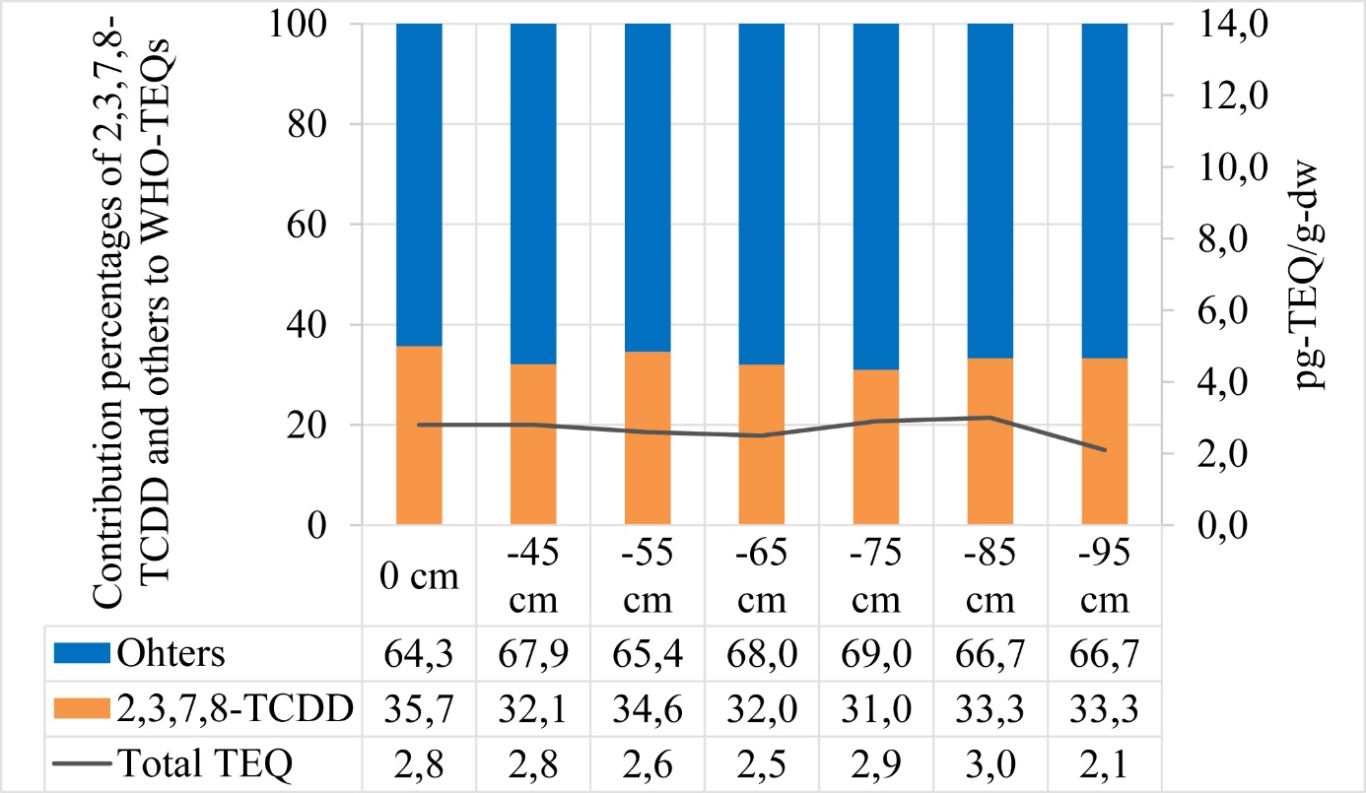
Figure 4. WHO-TEQs concentrations (pg-TEQ/g-dw) and percentages of 2,3,7,8-TCDD (%) by depth of borehole TK16 (cm)
Sediment quality assessment
The assessment of sediment qualities based on dioxin concentrations in sediments in the CGM compared with those according to Canadian standards and Vietnamese standards is shown in Table 3. The results indicate that the total WHO-TEQs concentrations are from 2 to 10 times lower than those in sediments officially regulated by Ministry of natural resources and environment (2012). According to Canadian sediment quality standards (Canadian Council of Ministers of the Environment 2019), The WHO-TEQs in the study are greater than 0.85 pg-TEQ/g- dw, which are able to be temperately utilized for sediment quality assessment (ISQG - Interim sediment quality guidelines). However, those most concentrations are far low to compare with TELs and PELs, except the concentrations in 95 ± 10 cm of the core TK10. Thus, dioxin concentrations in the study are not likely to expose benthic organisms to danger.
Table 3. Comparison in dioxin concentrations (pg-TEQ/g-dw) in sediments of the CGM according to officially regulatory indexes of Canada and Vietnam
|
This study in the Can Gio mangrove forest |
Vietnamese standards |
Canadian standards |
|||
|
Boreholes |
WHO-TEQs |
|
ISQG |
TEL |
PEL |
|
TK10 |
2,7 -13,0 |
21,5 |
0,85 |
8,5 |
21,5 |
|
TK16 |
2,1 – 3,0 |
||||
Vertical distributions of dioxins
Figure 5 shows the WHO-TEQs concentrations distributed in depth of the two boreholes TK10 and TK16. Of the borehole TK16, the WHO-TEQs concentrations distribute quite evenly from the surface to 95 cm. Meanwhile, the WHO-TEQs concentrations of the borehole TK10 illustrate an increase in depth, peak in 95 cm ± 10 cm, then they decrease rapidly to be equivalent to those in the surface layers. The abnormality of dioxin concentrations in 95 ± 10 cm with 13 pg-TEQ/g-dw is likely to be a certain clue for defoliant sprayed down during the Vietnam war. Other results that were found in 1974 by the American National Academy of Sciences, showed a great amount of dioxins in surface sediments in the CGM derived from defoliants, of which, they contained agent orange (2,4,5-DDT in range from 200 to 1200 ppb) and agent pink (piclogram in range from 10 to 50 ppb). In addition, another evidence shows that a lot of charcoals and plant humus appeared in about 95 ± 10 cm layer, shown in figure 6, is easily identifiable via structure description of the core, probably corresponding to the wartime. Sediment characteristics of the CGM are mostly homogeneous with over 90% fine silty clay in rich carbon, dominated by montmorillonite clay from the surface to bottom of the cores. This could be attributed to the immobilization of dioxins in sediments (Wu, et al. 1997, Lee, et al. 2006, Yeager, et al. 2007, Bergknut, Laudon and Wiberg 2010, Louchowarn, et al. 2018). The spraying period of defoliants showered down the CGM was recorded from 1965 to 1970, of which the most accounting for 35.3% of total amount was sprayed in 1967 (U.S. Air Force Communication Services 1965, U.S. National Academy of Sciences 1974). Therefore, the 1967 ± 3 can be used as a time marker to study sediment age in the CMG.
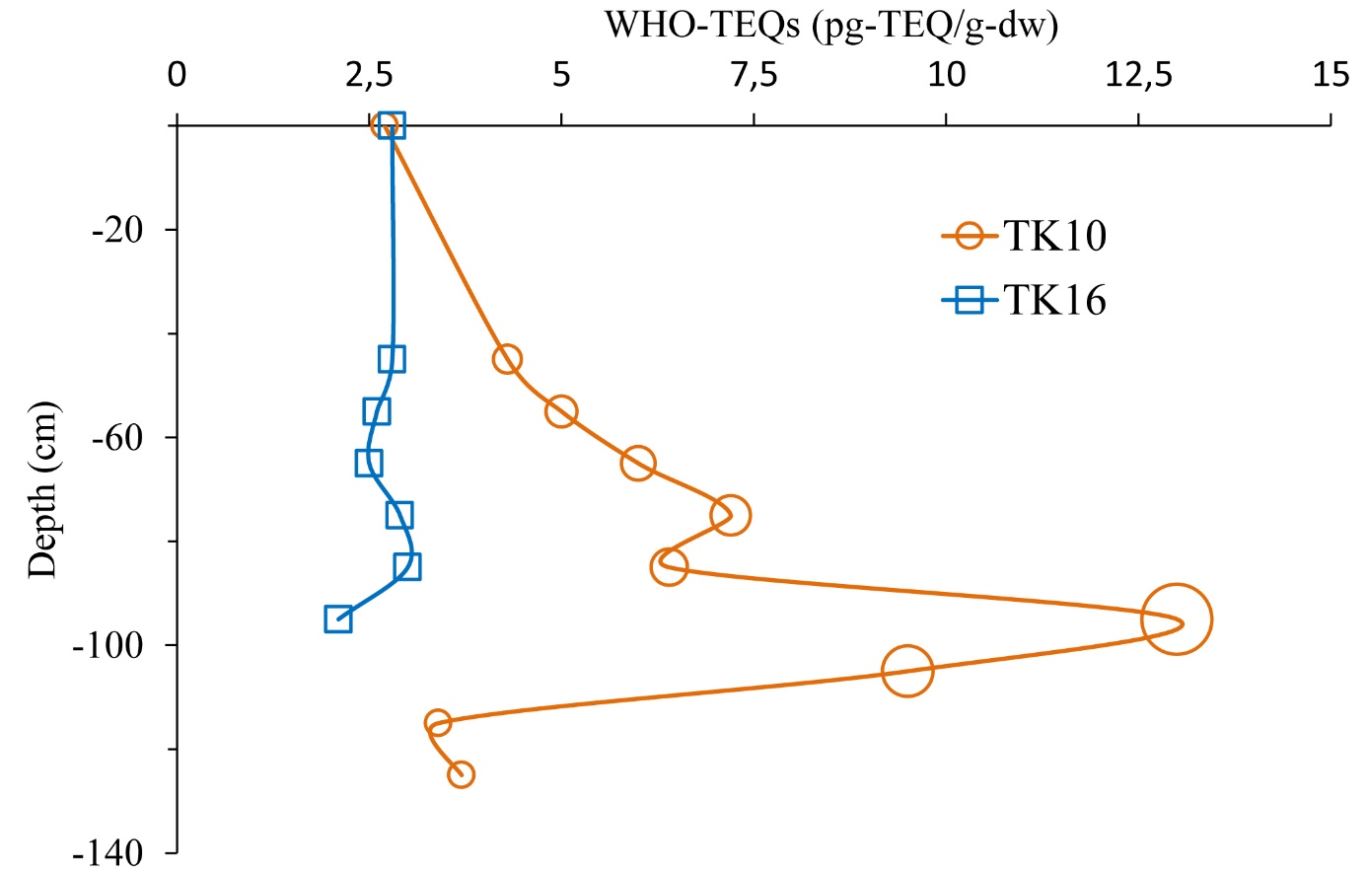
Figure 5. Distribution of dioxin concentrations in depth of the cores (cm)
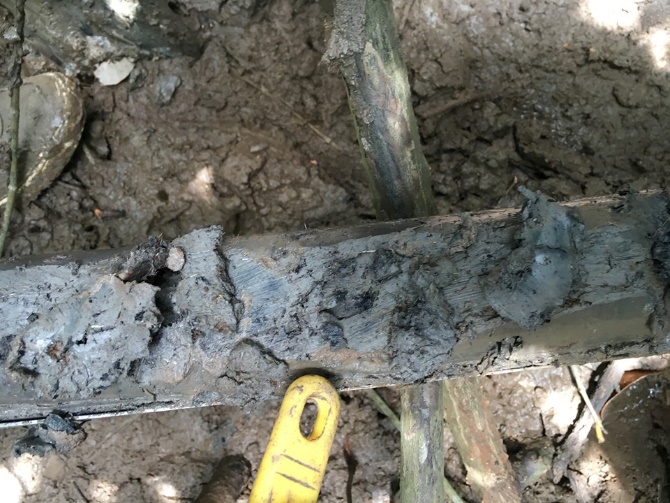 |
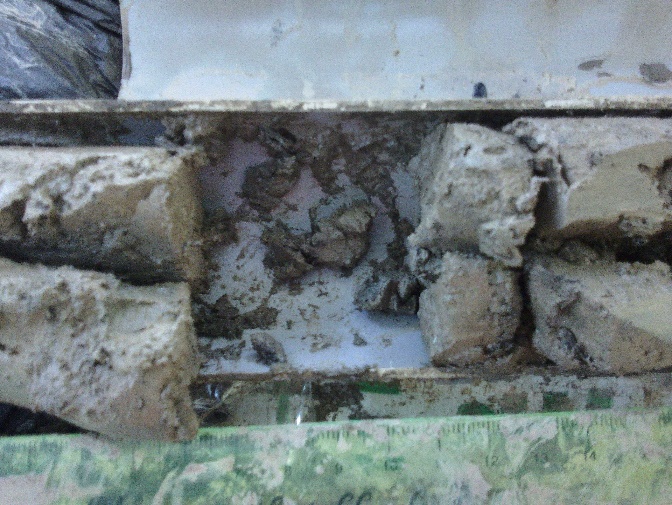 |
Figure 6. Charcoals and humus clearly displayed in 95 ± 10 cm of the borehole TK10 (March 7th, 2018 shots)
Conclusion
The total WHO-TEQ concentrations from 2.1 to 13 pg-TEQ/g-dw in sediments of the cores TK16 and TK10 in the CGM are relatively low and certainly present a safe environment for the benthic organisms. The concentrations mostly attributed to human activities due to the greatly contributed percentages of 2,3,7,8-TCDD, are appropriately representative for the background concentrations in the last 20 years. Abnormality of concentrations peaked in 13 pg-TEQ/g-dw in 95 ± 10 cm of the core TK10 suggests that the dioxins were mainly derived from defoliants sprayed during the Vietnam war. This peak concentration could be used for verifying sediment age in the CGM.
Acknowledgement
This research is funded by Ho Chi Minh City University of Technology (HCMUT), VNU-HCM under grant number BK-003249-2020.
Thanks to great supports from Yagai Kagaku Co.Ltd, Japan for dioxin analysis.
Tran Trong Hung, Dang Thuong Huyen, Tran Anh Tu, Bui Trong Vinh
Geology and Petroleum Engineering, HCMC University of Technology
(Source: Vietnam Environment Administration Magazine, English Edition I - 2021)
Anh, Mai Tuan, Do Hong Lan Chi, Nguyen Ngoc Vinh, Tu Thi Cam Loan, Lam Minh Triet, Kristin Becker-Van Slootenb, and Joseph Tarradellas. 2003. "Micropollutants in the sediment of Sai Gon – Dong Nai rivers: Situation and ecological risks." Chimia International Journal for Chemistry 57 (09): 537–541.
Bergknut, Magnus, Hjalmar Laudon, and Karin Wiberg. 2010. "Dioxins PCBs and HCB in soil and peat profiles from a pristine boreal catchment." Environmental pollution 158: 2518-2525.
Bopp, Richard F., Michael L. Gross, Huayi Tong, H. James Simpson, Stephen J. Monson, Bruce L. Deck, and Fredrika C. Moser. 1991. "A major incident of dioxin contamination: sediment of New Jersey estuaries." Environmental Science and Technology 25: 951-956.
Canadian Council of Ministers of the Environment. 2019. Canadian sediment quality guidelines for the protection of aquatic life: Polychlorinated dioxins and furans (PCDD/Fs). 12 9. Accessed 12 9, 2019. http://ceqg-rcqe.ccme.ca/en/index.html#void.
Dwernychuk, L. Wayne, Hoang Dinh Cau, Christopher T. Hatfield, Thomas G. Boivin, Tran Manh Hung, Phung Tri Dung, and Nguyen Dinh Thai. 2002. "Dioxin reservoirs in southern Viet Nam—A legacy of Agent Orange." Chemosphere 47: 117–137. doi:S00 4 5-6 5 35 (0 1 )0 03 0 0- 9.
Ferrario, Joseph B, and Christian J. Byrne. 2000. "2,3,7,8-Dibenzo-p-dioxins in mined clay products from United States: Evidence for possible natural origin." Environmental sciences and Technology 34: 4524-4532.
Gadomski, Damien, Mats Tysklind, Robert L. Irvine, Peter C. Burns, and Rolf Andersson. 2004. "Investigations into the vertical distribution of PCDDs and mineralogy in three ball clay cores from the United States exhibiting the natural formation pattern." Environmental Science & Technology 38 (19): 4956-4963.
Gaus, Caroline, Gregg J. Brunskill, Roland Weber, Olaf Papke, and Jochen F. Muller. 2001. "Historical PCDD input and their source implications from dated sediment core in Queenland (Australia)". Environmental Science and Technology, 35 4597-4603.
Heimstad, Eldbjørg Sofie, Gaute Grønstøl, Karl Torstein Hetland, Javier Martinez Alarcon, Charlotta Rylander, and Espen Mariussen. 2015. "A survey of dioxin-like contaminants in fish from recreational fishing". Environ Monit Assess (2015) 187: 509 187 (509): 1-13. doi:10.1007/s10661-015-4728-7.
Holmstrand, Henry, Damien Gadomski, Manolis Mandalakis, Mats Tysklind, Robert Irvine, Per Andersson, and Orjan Gustafsson. 2006. "Origin of PCDDs in ball clay assessed with compound-specific chlorine isotope analysis and radiocarbon dating." Environmental Science and Technology 40 (12): 3730-3735.
Shiozaki, Akira, Masayuki Someya, Tatsuya Kunisue, Shin Takahashi, Bui Cach Tuyen, Hideshige Takada, and Shinsuke Tanabe. 2009. "Contamination status of dioxins in sediments from Saigon river estuary, Vietnam." TERRAPUB 31-45.
Tuan, Le Duc, Tran Thi Kieu Oanh, Cat Van Thanh, and Nguyen Dinh Qui. 2002. Can Gio mangrove biosphere reserve. HCM city: Agriculture Publisher.
Thuong, Nguyen Van, Nguyen Xuan Hung, Nguyen Thi Mo, Nguyen Manh Thang, Pham Quang Huy, Hoang Van Binh, Vu Duc Nam, Nguyen Van Thuy, Le Ke Son, and Nguyen Hung Minh. 2014. "Transport and bioaccumulation of polychlorinated dibenzo-p-dioxins and dibenzofurans at the Bien Hoa Agent Orange hotspot in Vietnam". Environmental Science and Pollution Research 25: 50-62. doi:10.1007/s11356-014-3946-9.
U.S Agency for International Development. 2016. Dioxin Contamination on and around Bien Hoa Airbase - Environmental Assessment of Dioxin Contamination at Bien Hoa Airbase” Final Environmental Assessment, AID-EDH-1-00-08-00023. Massachusetts 02109: The American People.
U.S. Air Force Communication Services. 1965. HERBS Tape: Defoliation missions in Southern Vietnam, 1965-1971 by province. Memo Printout, Washington, DC 20330-1670: United States Air Force Communication Services.
U.S. National Academy of Sciences. 1974. The effects of herbicides in Viet Nam: Part A Summary and conclusion. Washington DC: United States National Academy of Sciences.
Van de Berg, Martin. 2006. “The 2005 World Health Organization re-evaluation of human and mammalian toxic equivalency factors for dioxins and dioxin-like compounds.” Toxicol Sci. October; 93(2): 223-241.
Wu, W.Z., K.-W Schramm, B. Henkelmann, A.Yedile Y. XII’, and and A. Kettrup. 1997. "PCDD/Fs, PCBs, HCHs and HCB in sediments and soils of Ya-er lake area in China: Results on residual levels and correlations to the organic carbon and the particle size." Chemosphere 34 (1): 191-202.
Yake, Bill, Stacie Singleton, and Karol Erickson. 1998. Washington State dioxin source assessment. Washington 98504-7600: Washington State Department of Ecology, Publication No. 98-320.
Yeager, Kevin M., Peter H. Santschi, Hanadi S. Rifai, Monica P. Suarez, Robin Brinkmeyer, Chin-Chang Hung, Kimberly J. Schindler, Michael J. Andres, and Erin A. Weaver. 2007. "Dioxin chronology and fluxes in sediments of the Houston Ship channel, Texas influences of non-steady state sediment transport and total organic carbon." Environmental Science and Technology, Vol.41 5291-5298.